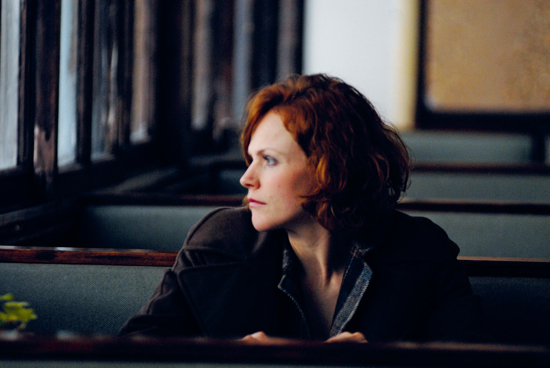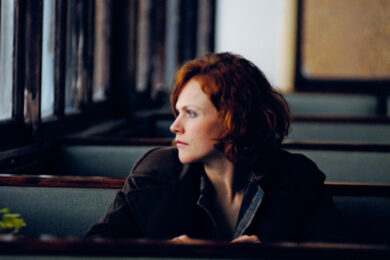"I think every filmmaker works through inspiration, but also through trying to find ways of expressing their own urgency and need to explain something about the world they’re looking at." Carol Morley
If the BFI’s Made In Britain season is intended to put the spotlight on individual filmmakers, it also offers a chance to make connections between them. A quirk of scheduling placed Lucy Walker’s documentary Devil’s Playground ahead of Carol Morley’s The Alcohol Years, which revealed unexpected links between the two. In the former, kids from the controlled environment of an Amish community are thrown out into the real world to experience rumspringa, a rite of passage that tests their commitment to the Amish way of life. After a year or two of drinking, dancing, driving and other "English" behaviours, they then must choose whether to return to the bosom of their community or make their way, alone, in the world.
Carol Morley had a similar test, exploring the hedonism of the 1980s Hacienda scene in Manchester for five turbulent years, before fleeing to London, a story told in her documentary The Alcohol Years, released in 2000. She has gone on to make last year’s highly regarded Dreams Of A Life and has a new film out, Edge, all three of which are showing as part of Made In Britain.
As Morley explained at the screening of The Alcohol Years, the idea for the doc came from a chance meeting in 1999 with the boyfriend of director Clio Barnard (whose 2010 film The Arbor showed two weeks ago in the series). He told Morley stories about herself that she didn’t remember, which led to her pursuing the topic on camera: "I began to wonder about how you are defined through other people."
It is a theme that runs through Morley’s work up through Dreams Of A Life, but is less clear in Edge, a work of fiction, which has had a difficult time. It was shot while she struggled to fund Dreams Of A Life, premiered in 2010 at the London Film Festival, and then sat on the shelf until now. In contrast to the hedonism of The Alcohol Years, the characters’ turmoil in Edge is largely contained within, set against a wintry backdrop of bleached white cliffs, waves crashing on the shore, and seagulls screaming in a most Du Maurierian manner.
With a Friday the 13th release date and the bleak coastal setting, one might imagine Edge to be a thriller or slasher flick. But, while the scene is set for Jason to turn up with his machete, Morley is concerned with a different kind of dismemberment – the emotional kind. Jason doesn’t turn up, but a cast of ne’er-do-wells does, chief among them Maxine Peake’s lost soul Elly, haunted by a youthful incident on the cliffs. She spends most of her time clutching a camera, staring into space and avoiding the attentions of Paul Hilton’s washed-up pop star Glen. For a long time Elly refuses to give him her name, and he struggles to write a song about this withdrawn woman whom he nicknames Garbo.
If the latter’s mysterious phone calls and collection of newspaper clippings provide some kind of plot, most of the running time is taken up with the characters attempting to find some connection with each other, interrupted by the odd Morley quirk of a musical number or a lecture on the geology of cliffs. One learns little about the staff, other than light-fingered chambermaid Agata (Anna Wendzikowska), who bonds with bad-tempered elderly guest Wendy (Marjorie Yates). As receptionist Linda (Julie T Wallace) pieces her jigsaw puzzle together, the hotel guests avoid each other, come together reluctantly, and then back off from resolution, until the inevitable confrontation on the clifftop. For what is the point of calling your film Edge and setting it on a cliff, if someone doesn’t scale the heights and go to the edge?
Hilton gets most of the humorous moments, desperately searching for inspiration, as he chats up his Garbo. Peake has a difficult role, carrying her hurts close to the surface, her voice a cracked whisper that is, at times, hard to hear. Nichola Burley is impressive as Sophie, a young woman on an awkward assignation, her dynamic with Joe Dempsie’s young man Philip changing dramatically as she reveals the reason for their meeting. What with storms brewing and puzzle pieces being assembled, clearly there is a whole lot of metaphor-ing going on. Some of it is a bit clunky and obvious, but Morley’s affection for her damaged characters makes this film a quiet pleasure.
The visuals provide an otherworldly ambience. In contrast to the grim interiors, all brown tones and awful wallpaper, the exteriors are blindingly white, a combination of snow, sand and sky. More metaphors, no doubt, but beautifully realised. When Agata drags Wendy outside for a night-time drive, it is the elderly woman who grabs the wheel, before bounding out of the vehicle for a waltz lit by headlamps that pick out the swirling snow. It is the most beautiful scene in the film.
In The Alcohol Years, one interviewee recalls a heartfelt letter from the young Morley bemoaning her "floundering". At the screening, the director explained her motivation in making Edge: "Something I am fascinated by is how, as a collection, a collective, we can make something of our lives beyond the isolation. So, I guess I always want to make some attempt in my films to bring people together."
Made In Britain runs at BFI Southbank until April 30. Edge plays there on April 22, 28 and 29 and is also on limited theatrical release nationwide; more information here. The film is out on DVD today through Dogwoof.



